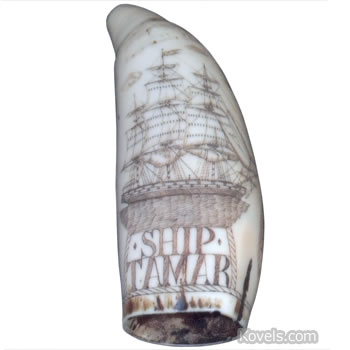Q: Years ago at an antique shop on Martha’s Vineyard, I bought a sperm-whale tooth carved with scrimshaw and dated 1861. I paid about $400 for it. I was told it was authentic. It weighs 12 ounces and is 6 1/4 inches tall. Recently I saw a picture of a tooth online that appeared to be identical selling for about $20 to $30. It was advertised as a copy of a whale’s tooth. How can I tell if the tooth I own is an original real whale’s tooth or a plastic copy with little value? If it is real, can you give me an approximate current value?
A: The HMS Tamar, the ship identified on your piece, was a British troop ship. The keel was laid down in 1861 and the ship was launched in 1863. It was scuttled in 1941. Sailors on whaling ships first made scrimshaw carvings on whales’ teeth in about 1800. True scrimshaw is one-of-a-kind, while fakes are mass-produced on plastic, bone, or other material. Some fakes are so good that only an expert can tell the difference, but there are clues that can help you spot a fake. The tip of an authentic whale’s tooth is yellowish and may have age lines. The patina is uneven and may be stained. Most fakes are whiter and have even coloring. If the patina can be scratched off, it’s fake. An authentic whale’s tooth has a deep, cone-shaped hollow interior and a thin bottom edge. The inside of fake scrimshaw is shallower and rounded, and the edge is smooth where the plastic was trimmed off. It used to be thought you could test for plastic by using a hot needle to pierce it, but this test doesn’t work on newer materials. For more information about fake scrimshaw, see “Fakeshaw: A Checklist of Plastic ‘Scrimshaw'” by Dr. Stuart M. Frank, available from The Museum Store, WhalingMuseum.org. Real scrimshaw can sell for hundreds of dollars or hundreds of thousands of dollars, depending on the age, condition, subject matter, and quality of the carving.




There is a very simple test to tell if a piece of scrimshaw is authentic and ivory, or a resin copy. You can use the static test. Rub the piece on your shirt. Then take a small piece of paper, maybe the size of a penny, and see if the piece will attract the paper. Ivory will not conduct a static charge, plastics and resin will. After rubbing, if the tooth will attract and pick up the piece of paper, then it’s a type of artificial resin. If it’s ivory, or even bone will work, it won’t attract the paper. Paul
From the Antiques Roadshow I recall there IS a method to tell the difference.
All mammal protein is the same and will SMELL the same when burnt, like hair.
From inside take a few shavings and hold a match to one.
If it smells like burning hair it genuine.
If it smell like burning plastic – it is.
I have had a ‘fakeshaw’ of this tooth in my hands, and this looks to be the same. Is the bottom hollow or filled in?